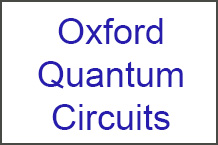Dear ,
Oxford Quantum Circuits Limited, founded by Dr Peter Leek (Oxford) in June 2017, is aiming to build a quantum computer based upon a superconducting circuit approach to forming qubits. The intention is to leverage the latest technology in this field and overcome the key challenge that has confounded researchers to-date: scaling the system up to a large number of qubits.
In order to perform any useful quantum computing, it is necessary to implement an architecture consisting of a large number of qubits, with couplings between them, as well as wiring to enable control and readout of all (or a key subset) of the qubits.
However, such architecture is usually implemented using in-plane couplings and control & readout wiring, e.g. on the surface of a fabricated chip or circuit board, and it becomes increasingly difficult to accommodate the necessary wiring as the scale grows.
Until now, superconducting circuits have relied upon either a planar circuit arrangement, which has associated problems with control and measurement wiring density, or have used bulky waveguide-like microwave structures that are difficult to scale due to their size. Dr Leek’s idea uses the advantages of a conventional planar circuit configuration, but solves the associated wiring density problem.
First prototypes of the building block components of this system are already in development and the academic team predict that a state-of-the-art 9 computational qubit system can be achieved rapidly.
The Competition
There are a very small number of new quantum computing hardware start-ups.
The only dedicated quantum computing company with a marketable product at present is D-Wave. D-Wave was founded in 1999 with the aim of creating the world’s first quantum computer and has raised around $120m to-date. In 2015 D-Wave launched the D-Wave 2X which, it is claimed, has more than 1,000 qubits (not comparable to the 9 computational qubits above) and operates below 15 millikelvin. There is considerable controversy surrounding the potential of D-Wave’s approach to quantum computing, which has yet to definitively prove its power.
Rigetti Computing out of Berkeley is a notable start-up founded in 2013, which has raised $69.2m so far.
Greater competitive threats come from the R&D labs of large companies like IBM (which recently announced a $3bn quantum computing R&D programme) and, possibly most significantly of all, Google. Each of these companies are dedicating considerable resource to quantum computing research and have hired some of the best talent in the field. It is likely that at least some of the innovation breakthroughs that enable the next generation of computing will emerge from the laboratories of these well-resourced giants.
Oxford Quantum Circuits has an exclusive license to the patented IP from Oxford University.
The Market Opportunity
The market for quantum computers is a largely hypothetical topic at present given that a whole new market is in the process of being created. It is obviously nascent and is currently sustained entirely by the research budgets of governmental organisations, plus a handful of powerful and wealthy commercial organisations, most notably Google, IBM and one or two top-tier defence contractors.
The market today effectively consists of the small number of high value sales made by Canadian company D-Wave, the only commercial company dedicated to making and selling quantum computers.
One of the few pieces of market research to put a value on the quantum computing market cites an expectation that it will reach a value of over $26 Billion by 2020 (Source: Quantum Computing Market Forecast 2015-2020, Market Research Media Ltd), but that is a highly speculative estimate.
The current market for supercomputers (i.e. computers that sell for more than US$500k) is perhaps the most helpful current indicator for the size of the opportunity, although even that market does not directly translate as the opportunity available to quantum computing. This segment of that market was estimated to be worth $6.2bn in 2014 according to D-Wave. That again correlates with recent IDC market research, which put the total supercomputing market size at $5.6bn in 2012
The Team
Dr Peter Leek, Founder, is a Research Fellow in Condensed Matter Physics at Oxford. He supervises a team of 8 quantum computing researchers in his university lab.
The Investment Case
Given the very early stage of this opportunity, any discussion of specific return multiples is speculative at best.
The only useful data point at present is D-Wave, which is a private company, but it has a listed shareholder, Harris and Harris Group (NASDAQ:TINY). Based on publicly available information from Harris and Harris, we know that TINY’s valuation of its holding puts D-Wave’s enterprise value in 2015 at somewhere between $165 million and $330 million.
Clearly the justification for our belief that Oxford Quantum Circuits might offer an attractive return on investment is based on the potential for quantum computing to fundamentally disrupt the computer market.


